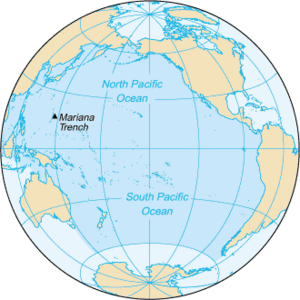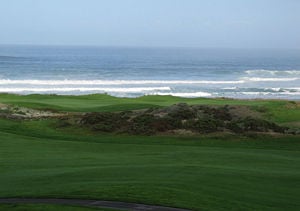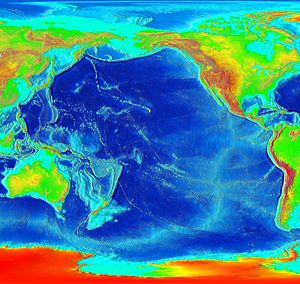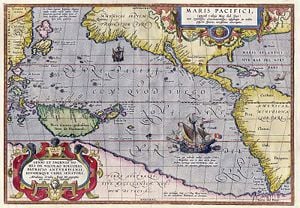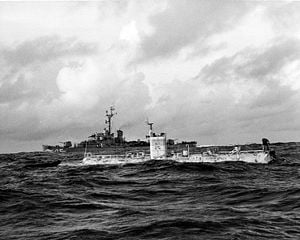Difference between revisions of "Pacific Ocean" - New World Encyclopedia
Keisuke Noda (talk | contribs) |
Keisuke Noda (talk | contribs) |
||
| Line 3: | Line 3: | ||
{{Five oceans}} | {{Five oceans}} | ||
[[Image:Pacific Ocean.png|right|300px|Pacific Ocean]] | [[Image:Pacific Ocean.png|right|300px|Pacific Ocean]] | ||
| − | The '''Pacific Ocean''' (from the [[Latin]] name ''Mare Pacificum'', "peaceful sea," bestowed upon it by the [[Portugal|Portuguese]] explorer [[Ferdinand Magellan]]) is the largest of the [[Earth]]'s [[ocean]]ic divisions. It extends from the [[Arctic]] in the north to the [[Antarctica|Antarctic]] in the south, bounded by [[Asia]] and [[Australia (continent)|Australia]] on the west and the [[Americas]] on the east. | + | The '''Pacific Ocean''' (from the [[Latin]] name ''Mare Pacificum'', "peaceful sea," bestowed upon it by the [[Portugal|Portuguese]] explorer [[Ferdinand Magellan]]) is the largest of the [[Earth]]'s [[ocean]]ic divisions. It extends from the [[Arctic]] in the north to the [[Antarctica|Antarctic]] in the south, bounded by [[Asia]] and [[Australia (continent)|Australia]] on the west and the [[Americas]] on the east. At 169.2 million [[square kilometre]]s (65.3 million [[square mile]]s) in area, this largest division of the [[World Ocean]] – and, in turn, the [[hydrosphere]] – covers about 46% of the Earth's water surface and about 32% of its total surface area, making it larger than all of the Earth's land area combined. <ref>"[http://concise.britannica.com/ebc/article-9374340/Pacific-Ocean Pacific Ocean]." ''[[Encyclopædia Britannica|Britannica Concise]].'' 2006. Chicago: Encyclopædia Britannica, Inc.</ref> The [[equator]] subdivides it into the '''North Pacific Ocean''' and '''South Pacific Ocean'''. |
| + | The ocean is the realm where future developments are expected. Considering its massive size and amount of potential resources, Pacific Ocean is considered to be an importance realm for future world economy. Expected economic development of Asian countries in the 21st centuries hints the rise of pan-pacific rim era. Peaceful corporation and mutual understanding are indispensable for its sustainable development and the establishment of safe global environment. Pan-pacific rim era also implies future cultural exchanges between the East and the West. | ||
== Water characteristics == | == Water characteristics == | ||
| Line 14: | Line 15: | ||
The [[South Equatorial Current]], flowing west along the equator, swings southward east of [[New Guinea]], turns east at about 50°S, and joins the main westerly circulation of the Southern Pacific, which includes the Earth-circling [[Antarctic Circumpolar Current]]. As it approaches the [[Chile]]an coast, the South Equatorial Current divides; one branch flows around [[Cape Horn]] and the other turns north to form the Peru or [[Humboldt Current]]. | The [[South Equatorial Current]], flowing west along the equator, swings southward east of [[New Guinea]], turns east at about 50°S, and joins the main westerly circulation of the Southern Pacific, which includes the Earth-circling [[Antarctic Circumpolar Current]]. As it approaches the [[Chile]]an coast, the South Equatorial Current divides; one branch flows around [[Cape Horn]] and the other turns north to form the Peru or [[Humboldt Current]]. | ||
| − | |||
[[Image:View-from-Spanish-Bay.jpg|300px|thumb|right|View of the Pacific Ocean from [[Pebble Beach, California]].]] | [[Image:View-from-Spanish-Bay.jpg|300px|thumb|right|View of the Pacific Ocean from [[Pebble Beach, California]].]] | ||
| − | |||
== Geology == | == Geology == | ||
The [[andesite line]] is the most significant regional distinction in the Pacific. It separates the deeper, [[mafic]] [[igneous rock]] of the Central Pacific Basin from the partially submerged continental areas of [[felsic]] igneous rock on its margins. The andesite line follows the western edge of the islands off [[California]] and passes south of the [[Aleutian Islands|Aleutian arc]], along the eastern edge of the [[Kamchatka Peninsula]], the [[Kuril Islands]], [[Japan]], the [[Mariana Islands]], the [[Solomon Islands]], and [[New Zealand]]. The dissimilarity continues northeastward along the western edge of the [[Andes]] Cordillera along [[South America]] to [[Mexico]], returning then to the islands off California. [[Indonesia]], the Philippines, Japan, New Guinea, and New Zealand—all eastward extensions of the continental blocks of [[Australia]] and [[Asia]]—lie outside the Andesite Line. | The [[andesite line]] is the most significant regional distinction in the Pacific. It separates the deeper, [[mafic]] [[igneous rock]] of the Central Pacific Basin from the partially submerged continental areas of [[felsic]] igneous rock on its margins. The andesite line follows the western edge of the islands off [[California]] and passes south of the [[Aleutian Islands|Aleutian arc]], along the eastern edge of the [[Kamchatka Peninsula]], the [[Kuril Islands]], [[Japan]], the [[Mariana Islands]], the [[Solomon Islands]], and [[New Zealand]]. The dissimilarity continues northeastward along the western edge of the [[Andes]] Cordillera along [[South America]] to [[Mexico]], returning then to the islands off California. [[Indonesia]], the Philippines, Japan, New Guinea, and New Zealand—all eastward extensions of the continental blocks of [[Australia]] and [[Asia]]—lie outside the Andesite Line. | ||
| Line 56: | Line 55: | ||
==Environmental Issues== | ==Environmental Issues== | ||
{{main|Marine pollution}} | {{main|Marine pollution}} | ||
| − | |||
Marine pollution is a generic term for the harmful entry into the ocean of chemicals or particles. The biggest culprit are rivers that empty into the Ocean, and with it the many chemicals used as [[fertilizers]] in agriculture as well as waste from [[livestock]] and [[humans]]. The excess of oxygen depleting chemicals in the water leads to [[hypoxia]] and the creation of a [[dead zone (ecology)]].<ref>Gerlach: Marine Pollution, Springer, Berlin (1975)</ref> | Marine pollution is a generic term for the harmful entry into the ocean of chemicals or particles. The biggest culprit are rivers that empty into the Ocean, and with it the many chemicals used as [[fertilizers]] in agriculture as well as waste from [[livestock]] and [[humans]]. The excess of oxygen depleting chemicals in the water leads to [[hypoxia]] and the creation of a [[dead zone (ecology)]].<ref>Gerlach: Marine Pollution, Springer, Berlin (1975)</ref> | ||
Revision as of 13:57, 10 July 2007
- "Pacific" redirects here.
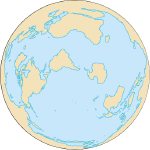
|
| Earth's oceans |
|---|
The Pacific Ocean (from the Latin name Mare Pacificum, "peaceful sea," bestowed upon it by the Portuguese explorer Ferdinand Magellan) is the largest of the Earth's oceanic divisions. It extends from the Arctic in the north to the Antarctic in the south, bounded by Asia and Australia on the west and the Americas on the east. At 169.2 million square kilometres (65.3 million square miles) in area, this largest division of the World Ocean – and, in turn, the hydrosphere – covers about 46% of the Earth's water surface and about 32% of its total surface area, making it larger than all of the Earth's land area combined. [1] The equator subdivides it into the North Pacific Ocean and South Pacific Ocean.
The ocean is the realm where future developments are expected. Considering its massive size and amount of potential resources, Pacific Ocean is considered to be an importance realm for future world economy. Expected economic development of Asian countries in the 21st centuries hints the rise of pan-pacific rim era. Peaceful corporation and mutual understanding are indispensable for its sustainable development and the establishment of safe global environment. Pan-pacific rim era also implies future cultural exchanges between the East and the West.
Water characteristics
Water temperatures in the Pacific vary from freezing in the poleward areas to about 25-30 °C [Celsius] 84 °F [Fahrenheit] near the equator. Salinity also varies latitudinally. Water near the equator is less salty than that found in the mid-latitudes because of abundant equatorial precipitation throughout the year. Poleward of the temperate latitudes salinity is also low, because little evaporation of seawater takes place in these frigid areas. The Pacific ocean is generally warmer than the Atlantic ocean.
The surface circulation of Pacific waters is generally clockwise in the Northern Hemisphere (the North Pacific Gyre) and counter-clockwise in the Southern Hemisphere. The North Equatorial Current, driven westward along latitude 15°N by the trade winds, turns north near the Philippines to become the warm Japan or Kuroshio Current.
Turning eastward at about 45°N, the Kuroshio forks and some waters move northward as the Aleutian Current, while the rest turn southward to rejoin the North Equatorial Current. The Aleutian Current branches as it approaches North America and forms the base of a counter-clockwise circulation in the Bering Sea. Its southern arm becomes the chilled slow, south-flowing California Current.
The South Equatorial Current, flowing west along the equator, swings southward east of New Guinea, turns east at about 50°S, and joins the main westerly circulation of the Southern Pacific, which includes the Earth-circling Antarctic Circumpolar Current. As it approaches the Chilean coast, the South Equatorial Current divides; one branch flows around Cape Horn and the other turns north to form the Peru or Humboldt Current.
Geology
The andesite line is the most significant regional distinction in the Pacific. It separates the deeper, mafic igneous rock of the Central Pacific Basin from the partially submerged continental areas of felsic igneous rock on its margins. The andesite line follows the western edge of the islands off California and passes south of the Aleutian arc, along the eastern edge of the Kamchatka Peninsula, the Kuril Islands, Japan, the Mariana Islands, the Solomon Islands, and New Zealand. The dissimilarity continues northeastward along the western edge of the Andes Cordillera along South America to Mexico, returning then to the islands off California. Indonesia, the Philippines, Japan, New Guinea, and New Zealand—all eastward extensions of the continental blocks of Australia and Asia—lie outside the Andesite Line.
Within the closed loop of the andesite line are most of the deep troughs, submerged volcanic mountains, and oceanic volcanic islands that characterize the Pacific basin. Here basaltic lavas gently flow out of rifts to build huge dome-shaped volcanic mountains whose eroded summits form island arcs, chains, and clusters. Outside the Andesite Line, volcanism is of the explosive type, and the Pacific Ring of Fire is the world's foremost belt of explosive volcanism.
Landmasses
The largest landmass entirely within the Pacific Ocean is the island of New Guinea— the second largest island in the world. Almost all of the smaller islands of the Pacific lie between 30°N and 30°S, extending from South-east Asia to Easter Island; the rest of the Pacific Basin is almost entirely submerged.
The great triangle of Polynesia, connecting Hawaii, Easter Island, and New Zealand, encompasses the island arcs and clusters of the Cook Islands, Marquesas, Samoa, Society, Tokelau, Tonga, Tuamotu, Tuvalu & Wallis and Futuna islands.
North of the equator and west of the International Date Line are the numerous small islands of Micronesia, including the Caroline Islands, the Marshall Islands and the Mariana Islands.
In the southwestern corner of the Pacific lie the islands of Melanesia, dominated by New Guinea. Other important island groups of Melanesia include the Bismarck Archipelago, Fiji, New Caledonia, the Solomon Islands and Vanuatu.
Islands in the Pacific Ocean are of four basic types: continental islands, high islands, coral reefs, and uplifted coral platforms. Continental islands lie outside the Andesite Line and include New Guinea, the islands of New Zealand, and the Philippines. These islands are structurally associated with nearby continents. High islands are of volcanic origin, and many contain active volcanoes. Among these are Bougainville, Hawaii, & the Solomon Islands.
The third and fourth types of islands are both the result of coralline island building. Coral reefs are low-lying structures that have built up on basaltic lava flows under the ocean's surface. One of the most dramatic is the Great Barrier Reef off northeastern Australia. A second island type formed of coral is the uplifted coral platform, which is usually slightly larger than the low coral islands. Examples include Banaba (formerly Ocean Island) and Makatea in the Tuamotu group of French Polynesia.
History and economy
- Further information: Oceania
Important human migrations occurred in the Pacific in prehistoric times, most notably those of the Austronesians (specifically, the Polynesians), from the Asian edge of the ocean to Tahiti and then to Hawaii and New Zealand, and much later, to Easter Island.
The ocean was sighted by Europeans early in the 16th century, first by the Spanish explorer Vasco Núñez de Balboa (1513), who crossed the Isthmus of Panama, and then by Ferdinand Magellan, who sailed the Pacific during his circumnavigation (1519-1522). In 1564, conquistadors crossed the ocean from Mexico led by Miguel López de Legazpi who sailed to the Philippines and Mariana Islands. For the remainder of the 16th century, Spanish influence was paramount, with ships sailing from Spain to the Philippines, New Guinea, and the Solomon Islands; the Manila Galleons linked Manila and Acapulco. In 16th century also Ragusan galleys fromDubrovnik led by Vice Bune explored southwestern Pacific, and discovered the islands of Bismarck Archipelago, Vanuatu (New Hebrides), etc.
During the 17th century, the Dutch, sailing around southern Africa, dominated discovery and trade; Abel Janszoon Tasman discovered Tasmania and New Zealand in 1642; in that century Ragusan traders prevailed in Melanesia. The 18th century marked a burst of exploration by the Russians in Alaska and the Aleutian Islands, the French in Polynesia, and the British in the three voyages of James Cook (to the South Pacific and Australia, Hawaii, and the North American Pacific Northwest).
Growing imperialism during the 19th century resulted in the occupation of much of Oceania by Great Britain and France, followed by the United States. Significant contributions to oceanographic knowledge were made by the voyages of HMS Beagle in the 1830s, with Charles Darwin aboard; HMS Challenger during the 1870s; the USS Tuscarora (1873-76); and the German Gazelle (1874-76). Although the United States conquered the Philippines in 1898, Japan controlled the western Pacific by 1914 and occupied many other islands during World War II. By the end of the war, the U.S. Pacific Fleet was the virtual master of the ocean.
Seventeen independent states are located in the Pacific: Australia, Fiji, Japan, Kiribati, Marshall Islands, Micronesia, Nauru, New Zealand, Palau, Papua New Guinea, the Philippines, Samoa, Solomon Islands, Republic of China (Taiwan), Tonga, Tuvalu, and Vanuatu. Eleven of these nations have achieved full independence since 1960. The Northern Mariana Islands are self-governing with external affairs handled by the United States, and Cook Islands and Niue are in similar relationships with New Zealand. Also within the Pacific is the U.S. state of Hawaii and several island territories and possessions of Australia, Chile, Ecuador, France, Japan, New Zealand, the United Kingdom, and the United States.
The exploitation of the Pacific's mineral wealth is hampered by the ocean's great depths. In shallow waters of the continental shelves off the coasts of Australia and New Zealand, petroleum and natural gas are extracted, and pearls are harvested along the coasts of Australia, Japan, Papua New Guinea, Nicaragua, Panama, and the Philippines, although in sharply declining volume in some cases. The Pacific's greatest asset is its fish. The shoreline waters of the continents and the more temperate islands yield herring, salmon, sardines, snapper, swordfish, and tuna, as well as shellfish.
In 1986, the member nations of the South Pacific Forum declared the area a nuclear-free zone in an effort to halt nuclear testing and prevent the dumping of nuclear waste there.
Environmental Issues
Marine pollution is a generic term for the harmful entry into the ocean of chemicals or particles. The biggest culprit are rivers that empty into the Ocean, and with it the many chemicals used as fertilizers in agriculture as well as waste from livestock and humans. The excess of oxygen depleting chemicals in the water leads to hypoxia and the creation of a dead zone (ecology).[2]
Major ports and harbours
|
|
See also
- War of the Pacific
- Asia-Pacific Economic Cooperation
- Pacific-Antarctic Ridge
- Pacific Coast
- Pacific hurricane
- Pacific Islands
- Pacific Rim
- Pacific Time Zone
- Pacific War
Further reading
- Based on public domain text from US Naval Oceanographer
- Barkley, Richard A. (1968). Oceanographic Atlas of the Pacific Ocean. Honolulu: University of Hawaii Press.
- (1985) Blue Horizons: Paradise Isles of the Pacific. Washington, D.C.: National Geographic Society. ISBN 0-87044-544-8.
- Cameron, Ian (1987). Lost Paradise: The Exploration of the Pacific. Topsfield, Mass.: Salem House. ISBN 0-88162-275-3.
- Couper, A. D. (ed.) (1989). Development and Social Change in the Pacific Islands. London: Routledge. ISBN 0-415-00917-0.
- Gilbert, John (1971). Charting the Vast Pacific. London: Aldus. ISBN 0-490-00226-9.
- Lower, J. Arthur (1978). Ocean of Destiny: A Concise History of the North Pacific, 1500-1978. Vancouver: University of British Columbia Press. ISBN 0-7748-0101-8.
- Napier, W. and Gilbert, J., and Holland, J. (1973). Pacific Voyages. Garden City, N.Y.: Doubleday. ISBN 0-385-04335-X.
- Oliver, Douglas L. (1989). The Pacific Islands, 3rd ed., Honolulu: University of Hawaii Press. ISBN 0-8248-1233-6.
- Ridgell, Reilly (1988). Pacific Nations and Territories: The Islands of Micronesia, Melanesia, and Polynesia, 2nd ed., Honolulu: Bess Press. ISBN 0-935848-50-9.
- Soule, Gardner (1970). The Greatest Depths: Probing the Seas to 20,000 Feet and Below. Philadelphia: Macrae Smith. ISBN 0-8255-8350-0.
- Spate, O. H. K. (1988). Paradise Found and Lost. Minneapolis: University of Minnesota Press. ISBN 0-8166-1715-5.
- Terrell, John (1986). Prehistory in the Pacific Islands: A Study of Variation in Language, Customs, and Human Biology. Cambridge: Cambridge University Press. ISBN 0-521-30604-3.
External links
- LA Times special Altered Oceans
- Oceanography Image of the Day , from the Woods Hole Oceanographic Institution
- EPIC Pacific Ocean Data Collection Viewable on-line collection of observational data
- NOAA In-situ Ocean Data Viewer Plot and download ocean observations
- Map South Pacific
- NOAA Ocean Surface Current Analyses - Realtime (OSCAR) Near-realtime Pacific Ocean Surface Currents derived from satellite altimeter and scatterometer data
- NOAA PMEL Argo profiling floats Realtime Pacific Ocean data
- NOAA TAO El Niño data Realtime Pacific Ocean El Niño buoy data
- South Pacific Organizer
ReferencesISBN links support NWE through referral fees
- ↑ "Pacific Ocean." Britannica Concise. 2006. Chicago: Encyclopædia Britannica, Inc.
- ↑ Gerlach: Marine Pollution, Springer, Berlin (1975)
be-x-old:Ціхі акіян
hak:Thai-phìn-yòng
frp:Ocèan Pacefico az:Sakit okean be:Ціхі акіян bi:Pasifik br:Meurvor Habask cv:Лăпкă океан gd:Cuan Sèimh ig:Pacific Ocean ilo:Taaw Pacifico kn:ಪೆಸಿಫಿಕ್ ಮಹಾಸಾಗರ sw:Pasifiki ml:ശാന്തമഹാസമുദ്രം sq:Oqeani Paqësor so:Badweeynta Baasifik sh:Tihi ocean tg:Уқёнуси Ором wa:Oceyan Pacifike bat-smg:Ramōsis vuondenīns
Credits
New World Encyclopedia writers and editors rewrote and completed the Wikipedia article in accordance with New World Encyclopedia standards. This article abides by terms of the Creative Commons CC-by-sa 3.0 License (CC-by-sa), which may be used and disseminated with proper attribution. Credit is due under the terms of this license that can reference both the New World Encyclopedia contributors and the selfless volunteer contributors of the Wikimedia Foundation. To cite this article click here for a list of acceptable citing formats.The history of earlier contributions by wikipedians is accessible to researchers here:
The history of this article since it was imported to New World Encyclopedia:
Note: Some restrictions may apply to use of individual images which are separately licensed.
